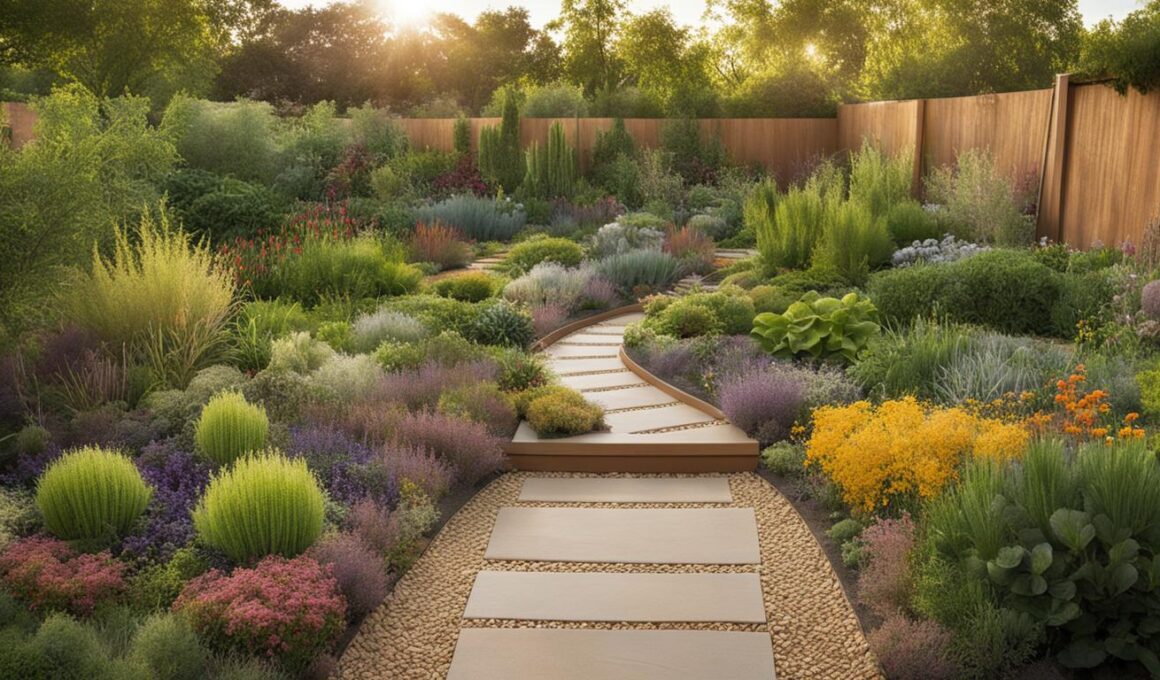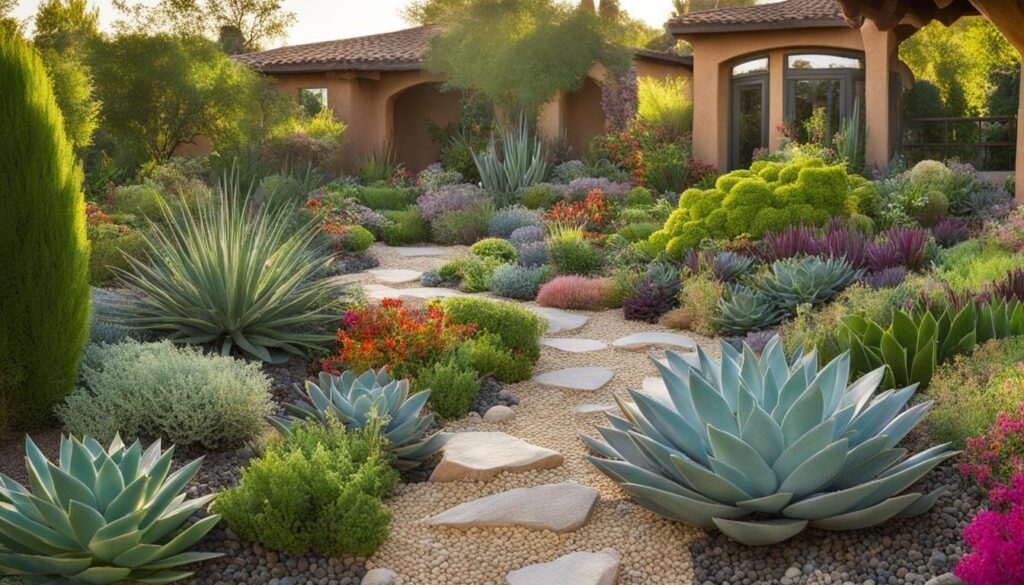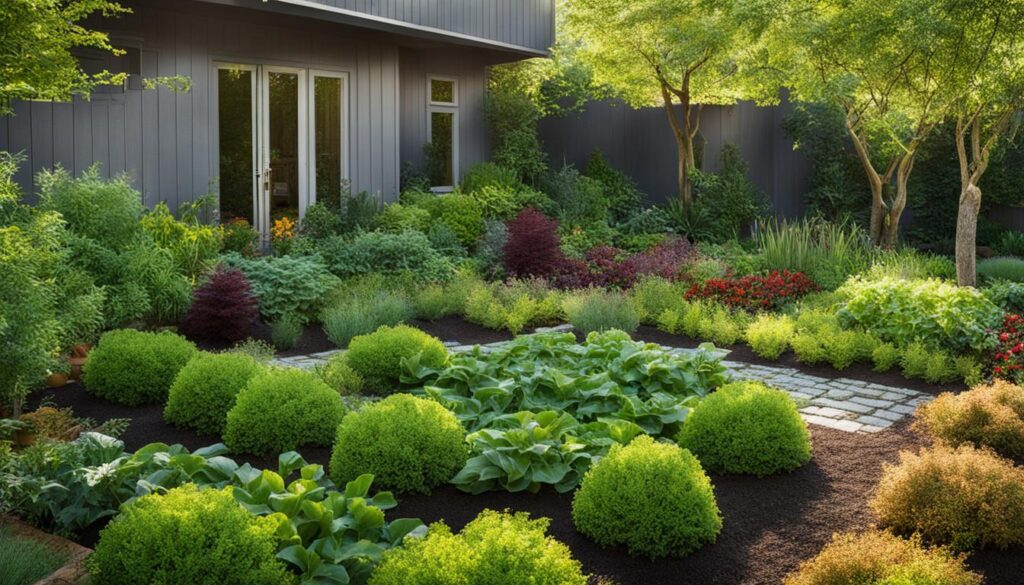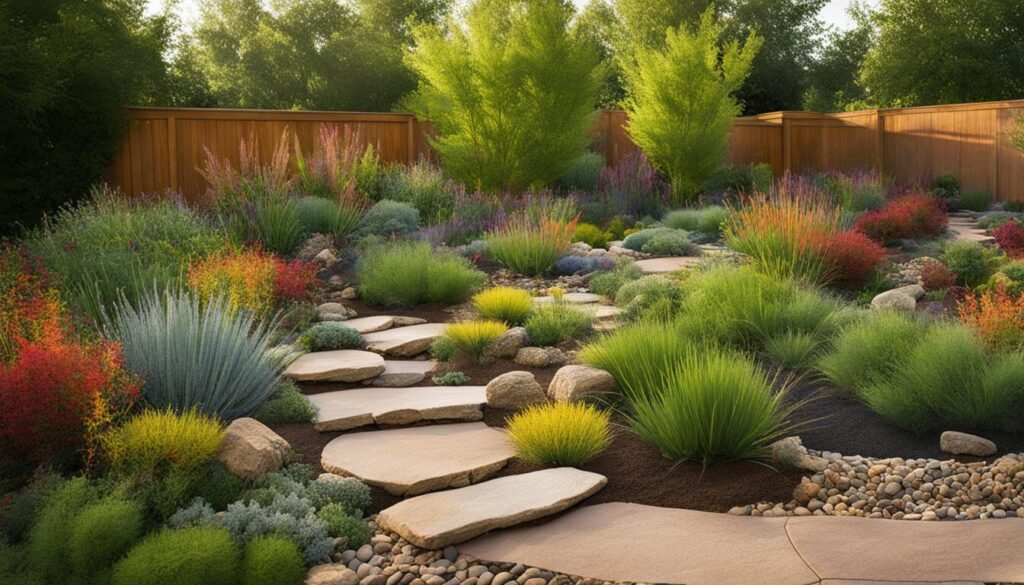Are you looking to transform your outdoor space into a sustainable and water-saving oasis? Look no further than the combined approaches of permaculture and xeriscaping. These two landscaping techniques can work together to create an ecosystem that is not only beautiful but also environmentally friendly. In this article, we will explore the benefits and principles of permaculture and xeriscaping and show you how to master your space using these sustainable landscaping techniques.
Key Takeaways:
- Permaculture and xeriscaping can be combined to create a sustainable outdoor space.
- Permaculture mimics nature and emphasizes regenerative practices and biodiversity.
- Xeriscaping focuses on conserving water and using drought-resistant plants.
- Combining permaculture and xeriscaping promotes water conservation, soil fertility, and resilience.
- Implementing permaculture and xeriscaping techniques requires observation, planning, and adaptation.
What is Permaculture?
Permaculture is a holistic approach to sustainable gardening and design that aims to mimic the patterns and principles found in natural ecosystems. It emphasizes regenerative practices, biodiversity, and the integration of plants, animals, and humans.
Permaculture principles include observing and learning from nature, using renewable resources, minimizing waste, and promoting self-sufficiency. By applying permaculture principles, you can create a resilient and productive landscape that not only benefits the environment but also provides a source of nourishment and beauty.
By incorporating permaculture techniques such as companion planting, food forests, and soil regeneration, you can create a self-sustaining ecosystem that mimics the complexity and resilience of natural systems. Through careful observation and thoughtful design, permaculture allows you to work in harmony with nature, maximizing resources and minimizing waste.
What is Xeriscaping?
Xeriscaping is a landscaping technique that focuses on conserving water and reducing the need for irrigation. It involves using drought-resistant plants, proper soil preparation, efficient irrigation systems, and mulching to create a low-water landscape. By carefully selecting and incorporating plants that are adapted to arid climates, xeriscaping can significantly reduce water usage without sacrificing the beauty and functionality of your outdoor space.
One of the key principles of xeriscaping is water-saving. By using plants that are well-suited to the local climate and soil conditions, you can minimize the need for supplemental watering. Drought-resistant plants, such as succulents and native grasses, have evolved to survive in dry environments and require less maintenance and water compared to traditional landscaping plants.
In addition to plant selection, proper soil preparation is crucial in a xeriscaped garden. The soil should be well-draining and enriched with organic matter to improve moisture retention and root growth. Mulching is another important step in xeriscaping. A layer of organic mulch, such as wood chips or shredded leaves, helps to retain moisture in the soil, suppress weeds, and regulate soil temperature.
The Benefits of Xeriscaping:
- Reduced water usage and lower water bills
- Less maintenance and time spent on watering
- Increased resilience to drought and water restrictions
- Improved soil health and fertility
- Promotion of native plant species and biodiversity
- Enhanced aesthetics with unique and diverse plant selections
Incorporating xeriscaping techniques into your landscaping not only benefits the environment but also provides long-term cost savings and a beautiful, sustainable outdoor space.
Benefits of Combining Permaculture and Xeriscaping
Combining permaculture and xeriscaping techniques in your outdoor space can offer numerous advantages. By integrating permaculture principles within a xeriscaped garden, you can create a self-sustaining ecosystem that requires minimal resources and maintenance. This combined approach promotes biodiversity, conserves water, increases soil fertility, and enhances the overall resiliency of your landscape.
One of the major benefits of combining permaculture and xeriscaping is the reduction in water usage. By incorporating drought-resistant and native plants into your permaculture design, you can further minimize the need for watering. This not only conserves water but also saves you time and effort spent on irrigation. With a carefully planned and executed combination of permaculture and xeriscaping, you can significantly reduce your outdoor water consumption while still enjoying a vibrant and lush landscape.
Another advantage of this combined approach is its positive impact on soil health. Permaculture principles, such as the use of organic matter and companion planting, contribute to the enrichment of the soil. When combined with xeriscaping techniques like mulching, which helps retain moisture and prevents soil erosion, you create an environment that supports the growth of healthy and nutrient-rich soil. This benefits the plants in your garden and promotes the overall long-term sustainability of your landscape.
Enhanced Resiliency and Sustainability
By integrating permaculture and xeriscaping, you also enhance the resiliency and sustainability of your outdoor space. Permaculture principles focus on building systems that are capable of adapting to changing conditions and minimizing reliance on external inputs. By implementing these principles within a xeriscaped garden, you create a landscape that can better withstand drought, extreme weather events, and other environmental challenges. Additionally, the use of native plants in your design further enhances the resilience of your ecosystem, as these plants are naturally adapted to the local climate and require less maintenance.
Overall, combining permaculture and xeriscaping offers a holistic and sustainable approach to landscaping. It allows you to create a beautiful and productive outdoor space while conserving water, improving soil health, and promoting biodiversity. Whether you have a small urban garden or a larger rural property, incorporating these techniques can have significant benefits for both you and the environment.
Case Study: A Successful Permaculture Food Forest in an Urban Backyard
One inspiring example of the successful combination of permaculture and xeriscaping is an urban backyard food forest in Melbourne. The garden was designed using permaculture principles to create a sustainable and productive ecosystem. Despite the challenges of limited space and poor soil quality, the garden thrived and produced an abundance of fruits, vegetables, and herbs.
The project’s success demonstrates that permaculture can indeed be implemented in urban areas and showcases the potential of combining permaculture and xeriscaping techniques. With careful planning and thoughtful design, even small spaces can be transformed into bountiful food-producing gardens.
“Our urban food forest has not only provided us with a sustainable source of fresh food but has also become a haven for birds, insects, and other wildlife. It’s truly a testament to the power of permaculture in creating a thriving ecosystem in an urban setting.”
The Melbourne food forest stands as a beacon of sustainable living in the heart of the city. It serves as a reminder that we can create self-sufficient and resilient food systems, even in urban environments. By harnessing the principles of permaculture and combining them with innovative design techniques like xeriscaping, we can turn our backyards into flourishing oases that benefit both ourselves and the planet.
Key Takeaways:
- Permaculture and xeriscaping can be successfully combined to create productive and sustainable urban gardens.
- Careful planning and thoughtful design are essential to overcome challenges such as limited space and poor soil quality.
- Permaculture food forests can provide a self-sufficient source of fresh food while attracting wildlife and promoting biodiversity.
How Can Permaculture and Xeriscaping Work Together to Create Sustainable Landscapes?
Permaculture and xeriscaping synergy strategies can work together to create sustainable landscapes by combining the principles of water conservation and sustainable agriculture. By integrating drought-tolerant plants and water-efficient designs, these techniques can minimize water usage while promoting biodiversity and ecological balance.
Tips for Implementing Permaculture and Xeriscaping in Your Own Space
If you’re looking to transform your outdoor space into a sustainable and beautiful landscape, incorporating permaculture and xeriscaping techniques can be a game-changer. Here are some practical tips to help you get started:
- Observe and analyze your site: Before diving into any design or implementation, take the time to thoroughly observe and analyze your space. Consider factors such as sun exposure, soil quality, and water availability. This will help you tailor your permaculture and xeriscaping approaches to the specific needs and characteristics of your site.
- Plan based on permaculture principles: The key to successful implementation is planning. Incorporate permaculture principles such as companion planting, stacking functions, and maximizing energy efficiency into your design. By carefully considering the needs and interactions of plants, animals, and humans, you can create a thriving and self-sustaining ecosystem.
- Integrate drought-resistant plants: Choosing the right plants is crucial for a water-saving landscape. Opt for drought-resistant and native plants that are well-suited to your climate. These plants require less water and maintenance, while still providing beauty and biodiversity to your garden.
- Efficient irrigation systems and mulching: Reduce water usage by implementing efficient irrigation systems such as drip irrigation or rainwater harvesting. Mulching is another essential technique that helps retain soil moisture, suppress weeds, and improve overall soil health.
Remember that implementing permaculture and xeriscaping techniques is an ongoing process. Continually learn, adapt, and experiment as your garden evolves. With time, patience, and dedication, you can create a sustainable and thriving outdoor space that reflects your commitment to the environment.
Conclusion
Permaculture and xeriscaping are two powerful approaches to sustainable landscaping that can be combined to create a harmonious and resilient ecosystem. By implementing permaculture principles in a xeriscaped garden, you can maximize resource efficiency, conserve water, and promote biodiversity.
Whether you have a small urban backyard or a larger rural property, the principles of permaculture and xeriscaping can be adapted to create a sustainable and beautiful outdoor space. By observing and analyzing your site, planning based on permaculture principles, and incorporating drought-resistant plants and efficient irrigation systems, you can create a thriving and resilient landscape.
Start incorporating permaculture and xeriscaping techniques today and be the change towards a more sustainable future. With these combined approaches, you can create a landscape that not only enhances your space but also contributes to a healthier environment. So, embrace these sustainable landscaping techniques and let your garden thrive while minimizing your ecological footprint.













